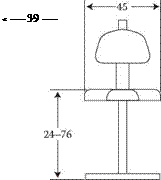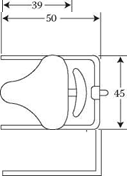In those cases where ordinary chairs cannot be used (for example, because the work surface is either too high or too low), special chairs can be used. For high work surfaces, load can be taken off the feet and legs by use of a ‘shooting stick’. The following must be taken into account in the design of these:
1. They must be able to be raised and lowered.
2. The support on the floor must not be able to slide away.
3. The seat surface must have well-rounded edges.
4. The seat surface must be padded.
5. The seat material must have good friction.
Figure 6.12 shows a special chair which can be used at both high and low workplaces. It is designed so that it can be easily moved between different workplaces. It can be raised from 240 mm to 660 mm above the floor. The seat depth is also adjustable and can be turned through ±30 degrees. The seat surface is so designed that the operator has support for the ischial tuberosities, while at the same time providing relatively good freedom of movement for the legs. The chair is a combination of an ordinary chair and a standing support chair/stool.
Chairs for all types of functions are needed in the control room. For normal monitoring work where no control or recording function is carried out, the look – ing/listening chair is perhaps the best. For more intensive recording and keyboard work and writing, the chair with the working function is the best. When working for
 |
 |
FIGURE 6.12 An example of a ‘standing-sitting’ chair adjustable over a wide range.
longer periods at a panel, where normally only occasional readings have to be taken, there may be a need for special chairs of the support type. There is no one combination chair that fulfils all these three functions. However, attempts have been made to produce chairs that satisfactorily fulfil working and certain resting functions (see, for example, Figure 6.13).



